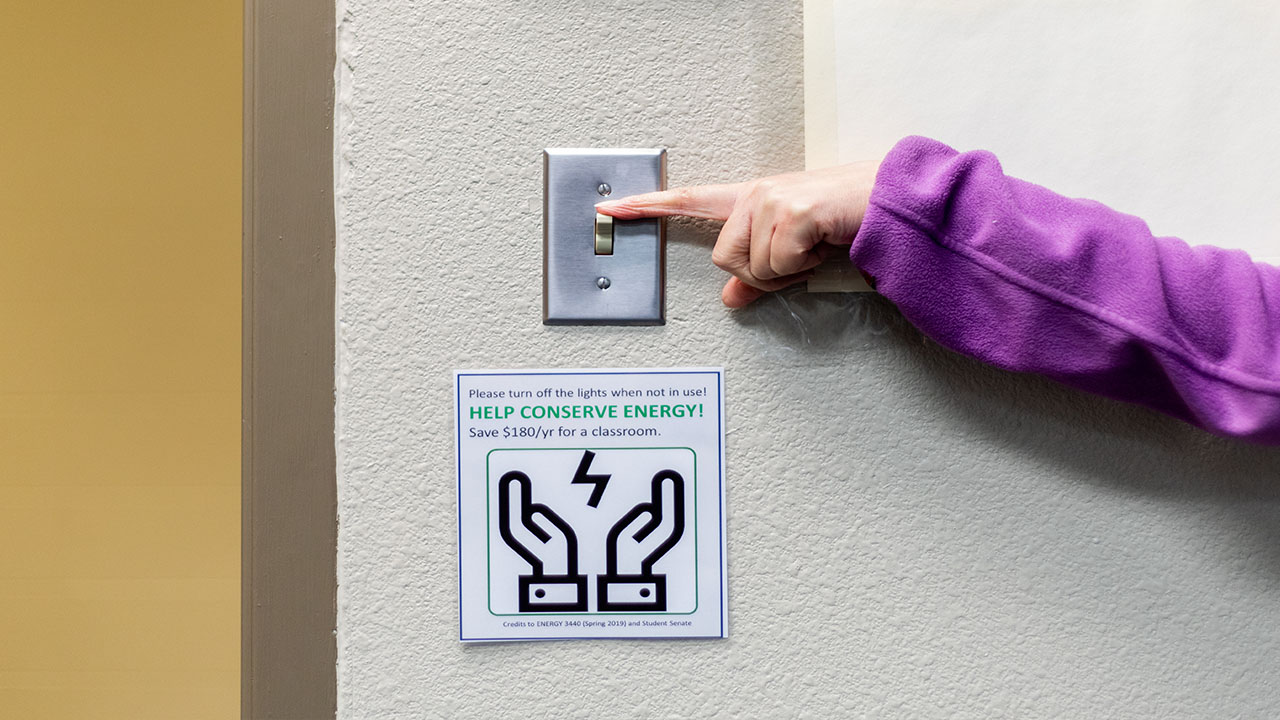
Anyone who has touched a light switch in the University of Wisconsin-Platteville’s Ottensman Hall recently may have noticed a small green placard near the plate urging people to turn the lights off when they leave the room. That placard is the work of Dr. Ilke Celik’s Green Building Design students, who are trying to get everyone to think about how the tiny choices they make add up to big energy savings. Along the way, Celik’s students learned a sobering lesson about the energy used by devices and lights when nobody is in the room, a lesson which Celik, an assistant professor of sustainability and renewable energy systems, hopes to expand to other buildings in the university – and beyond.
“My initial idea was for my spring design students to audit many buildings on campus, not only Ottensman. But for now, we decided to start with Otts,” said Celik, who teaches both Green Building Design and Sustainability courses within the Electrical and Computer Engineering Department. “We use a kilowatt device that shows how much power is consumed by each device. My students split into five-person teams, visited each classroom and tried to get an understanding of how much, and for how long, each piece of equipment is being used.”
The project called for some repeat visits and careful calculation. “For the computers, they would visit a classroom, see how many classes were held in the room, when computers are being used versus not used, and how much power consumption that use represented,” explained Celik. “They made multiple visits at different points in the week to collect raw data, so we ended up with some average values.”
Next, Celik encouraged her students to think deeply about how they could use the information they had gathered to make the university greener. “Our idea was to find cheap or zero-dollar solutions. So there were a lot of ideas for reducing consumption, like changing to lower-energy devices, but we wanted to see how we can encourage change without putting extra expense out. So after they made their first calculations, I met with my students and we'd go through all these suggestions, discussing if they made sense. Each team met with me, and there was a lot of feedback.”
Eventually, the class landed upon the idea of a public campaign to encourage small, environmentally friendly habits. “In terms of energy usage, the choice to turn off a light or a device is a really minor-seeming change, but it is very applicable, as opposed to something very costly,” said Celik. “In other words, really cheap solutions are also really implementable, and I wanted students to see how big an impact small changes can have on society.”
The idea for the placards was born. But how to design them? “I have a lot of engineering students, but some were also coming from business and from the SRES program, so the teams were very diverse in terms of background,” said Celik. Her class’s diversity of discipline came in handy when it was time to decide on issues of graphic design, typography and wording.
While it’s too early to tell what effect the placards will have on overall usage, Celik is already thinking about ways she can bring more students into the evolving conversation around energy usage and the environment.
“For the next semester, the project could possibly continue; I'm still in the thinking and planning process about that,” Celik said. “I'm wondering if I can take the approach from the Green Building Design class to the Sustainability class. It's a really important lesson that students can make this change.”
To reinforce the message, Celik made sure that each sign contained some important information. “We let them know in all the placards that the 2019 Green Design Class was responsible for them, so I think that will help draw attention to the impact of the class.”
All signs point to a big impact – and a greener future for UW-Platteville.